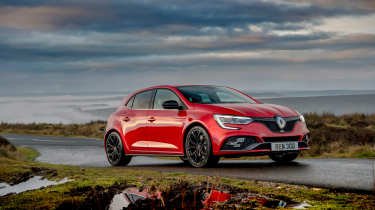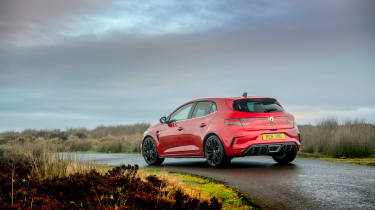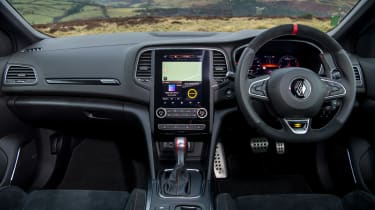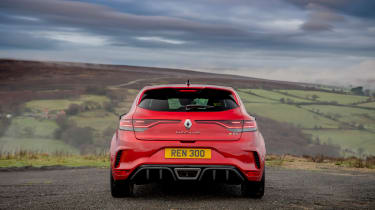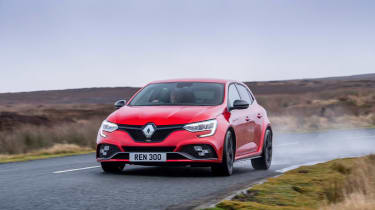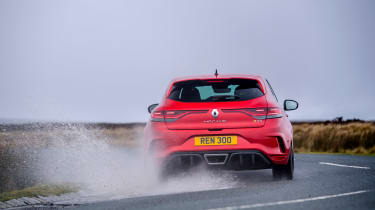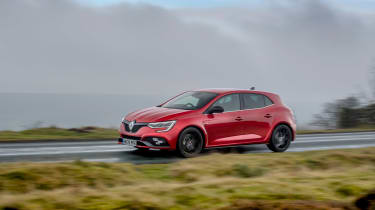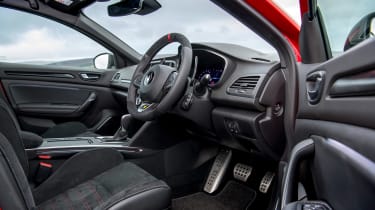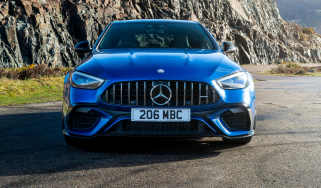Renault Megane RS 300 2021 review – less is more with this GTI rival
The new Renault Megane RS shines in its lesser trim, with a fluidity and poise that makes for a fantastic road-biased hot hatchback
The hot hatchback class might be deep under threat from increasingly tough emissions regulations and tax laws in Renault’s native France, but there are still lingering remnants from the once great French hot hatchback empire in today’s market. RenaultSport’s Megane, the last model before its transformation into Alpine, has been refreshed and restructured in 2021, reducing the range to just the top-tier Trophy and the entry-level Megane RS 300 we’re driving here.
Both share the same powertrain, but feature a different chassis tune, in a similar vein to many past RenaultSport products, as well as other specification and setup variances. It also features some new tech, and has dropped the six-speed manual entirely from the range.
Engine, transmission and 0-60 time
A major element of the new RS’s changes involve its consolidation to just one engine and transmission combination. The engine is the familiar turbocharged 1.8-litre four-cylinder petrol, bespoke to the RS within the Megane range, and shared with the Alpine A110.
With 1798cc, it might be short on capacity compared to most rivals, but feels good for its 297bhp power figure with a broad torque curve that builds early and with relatively little turbo lag thanks to a twin-scroll turbo. But the magic with this engine is that despite its low-end torque it still loves to rev, and has a fantastically boisterous character that goes beyond its vocal exhaust and propensity to pop and bang on down-changes.
More reviews
In-depth reviews
Reviews
- Renault Sport Mégane R26.R (2008 - 2009) review – Dieppe's finest hour
- Renault Megane E-Tech 2022 review
- Renault Megane RS sport chassis (2017-2020) review – forget the Trophy, basic is best with the Megane RS
- Renault Megane RS Trophy (2019-2020) review – is this Renault Sport’s redemption?
- Renault Megane RS cup chassis (2018-2020) review – sharp, even when you don't want it to be
- K-Tec Racing Mégane review - Renault Sport's impressive hot hatch gets 360bhp
The dual-clutch transmission is a willing sidekick and suits the engine remarkably well. The two are a familiar pairing from the Alpine A110 and, as in that car, it feels impressively responsive and decisive both up and down the ratios. On-paper performance is on-par for the class, the RS reaching 62mph in 5.7sec and topping out at 158mph.
Technical highlights
Peel back the Megane RS’s chunky bodywork and you’ll find an array of bespoke components, starting with the axles. Both are stretched compared to those on the regular Megane and the RS requires a completely bespoke body-in-white to cover them. While the use of different bodywork is not uncommon for hot hatchbacks, to go so far as to require a completely unique shell is a testament to the effort and finances that went to the development of this car. It also features a rear-wheel steering system, a chunky Brembo brake package and bi-modal exhaust.
There are still two chassis setup options, Sport and Cup, but as mentioned above are specifically designated to each variant – the entry-level RS 300 running the Sport chassis and the Trophy getting the Cup. As well as the completely different damper set up and spring rates, the Trophy also features standard 19-inch forged wheels, lighter brakes (albeit of the same dimension), and a limited slip differential, the importance of which we’ll come to in a second. The suspension, regardless of setup, also still features Renault’s clever hydraulic bump stops.
Aesthetic updates are subtle, with new lighting front and back outside, plus some new interior finishes, an updated infotainment screen and proper digital dial display replacing the previously half-digital, half-analogue unit.
What’s it like to drive?
Immersive, fluid and entertaining. Our drive in this case was limited to the standard RS 300 model on the ‘Sport’ chassis, and like the model that came before it’s a deeply impressive hot hatchback on the road. The first thing that strikes you is the fluidity and poise the chassis has over rough sections. It feels in complete contrast to ‘Cup’ models, and while they were never so clumsy as to knock you off-line or scrabble for traction, it was enough to sometimes knock the wind out of you in the driver’s seat.
The Sport chassis on the other hand feels languid, long-legged and superbly supple, but without losing too much of the Cup’s composure. It’s not quite as laterally stable as the Trophy, but its ability to lean into the suspension’s travel at road speeds actually makes the RS more transparent and trustworthy.
This is where the Megane’s rear-wheel steering comes into play. On the Cup chassis, the instant and sometimes aggressive rotation encouraged by the rear-steer can come without much warning, but the softer chassis seems to relax the rate of response. Instead it allows you to feel for that rotation, rather than having to react to it. The nose is pin sharp too, locking onto your chosen line through a corner and then opening up the opportunity to take control of the car’s balance coming out of it. Want to neutralise the body for maximum attack out of a corner? No worries. Feel like letting the tail loose? It’s just a lift of the throttle away.
The requisite fight with the clunky six-speed manual transmission in previous models is now replaced with a quick and responsive pull of a paddle. It certainly doesn’t feel like any degree of immersion into the RS’s driving experience is lost with the dual-clutch, it’s instead removed an interface that would often distract from, rather than add to, the driving experience.
The brakes are also particularly impressive, with great bite, tireless resistance to fade and impressive pedal feel. There is a slight dead spot at the top of the pedal travel, but once beyond this point they’re trustworthy and perfectly weighted to the other controls. If there is one thing missing on the ‘base’ RS 300 it’s a limited slip differential. The traction control system does a fairly good job of reining-in wheelspin, but that seductive pulling sensation LSDs create when accelerating out of tight corners is missing. Its absence does improve the steering though, and with so little torque steer its not quite such a compromise as you might expect in a 300bhp hot hatch.
There’s no doubt this RS 300 model is less able and entertaining on track than the Trophy, but on the road it’s such a big improvement you’d have to be pretty dedicated to ultimate track performance to make it a worthwhile compromise. Against rivals like the Volkswagen Golf GTI, BMW 128ti and Focus ST, the Megane RS 300 feels superbly judged, and seems to have found a sweet spot with its dual-clutch ‘box and sports chassis. This leaves the new dual-clutch-fitted Hyundai i30 N and next Cupra Leon 300 ripe for dispatch. Bring on the next group test.
Price and rivals
The new Megane RS has gone up in price, but is still competitively placed against rivals. The standard RS 300 with the Sports chassis we’re driving here starts at £32,995, and comes pretty much fully-loaded. Our test car did have a few options fitted, consisting of larger 19-inch wheels and some Alcantara appointments inside, but none were essential. Plump for the Trophy and that will start a further £4k up the scale at £36,995.
As for rivals, the low-£30k point is full of options, with some we like, and some we don’t. The £33,260 Ford Focus ST, while packed full of torque and with a pointy front end, feels like a weak link in the class once again. Its rather dull engine and odd steering quickly grate, while the optional automatic feels sloppy and underdeveloped.
The Golf GTI does its usual thing, with a slick powertrain and an impressive, if cold, chassis regardless of manual (£33,510) or DSG (£35,010) transmission options. BMW’s new £33,320 128ti is a new contender, ditching the M135i’s all-wheel drive system for front-wheel drive and a limited slip differential. It’s actually the more engaging car when up against the GTI, but feels a bit cheap inside, and you’ll have to look at its dull, yet still devastatingly ugly face on the driveway every day.
Really though, the Renault's two biggest competitors are still yet to come, with the new Cupra Leon 300 (with the 297bhp four-cylinder powertrain) and updated Hyundai i30 N both arriving in early 2021. As two non-premium hot hatchbacks, both will match or indeed undercut the Renault on price, but also be the closest in terms of both setup and prospective customer.

